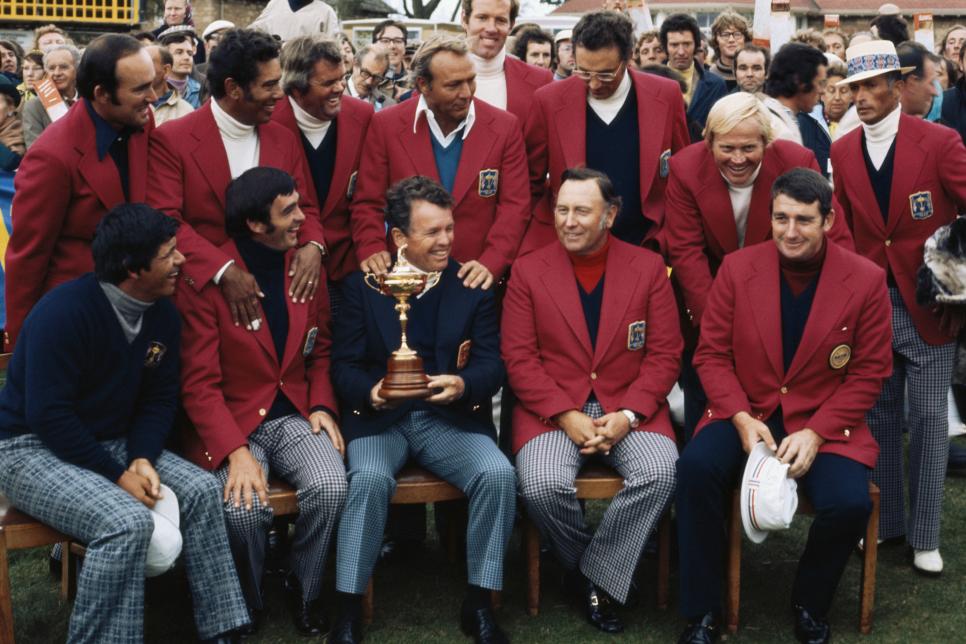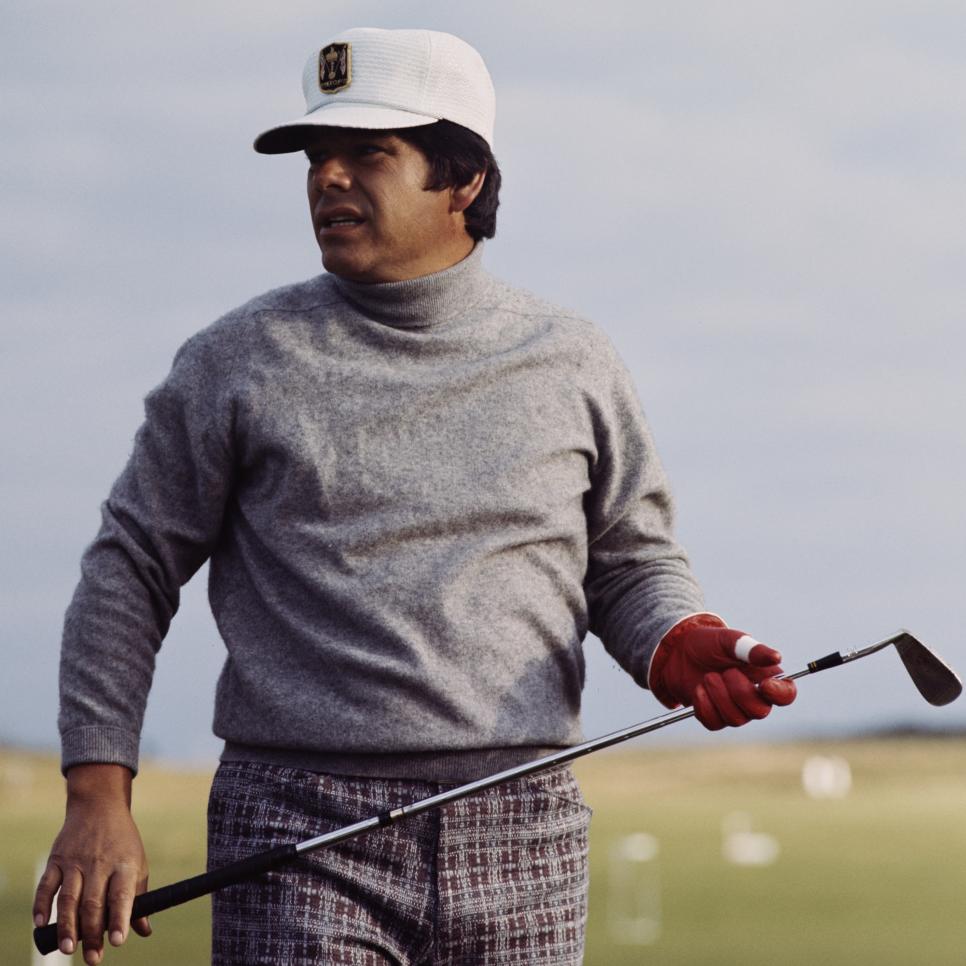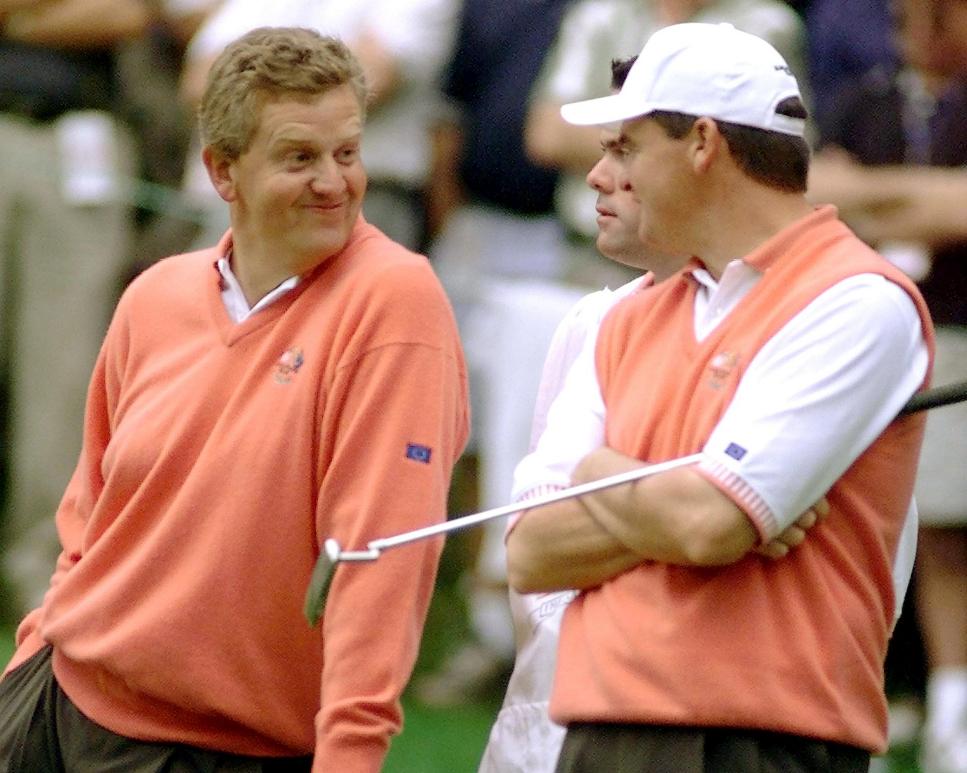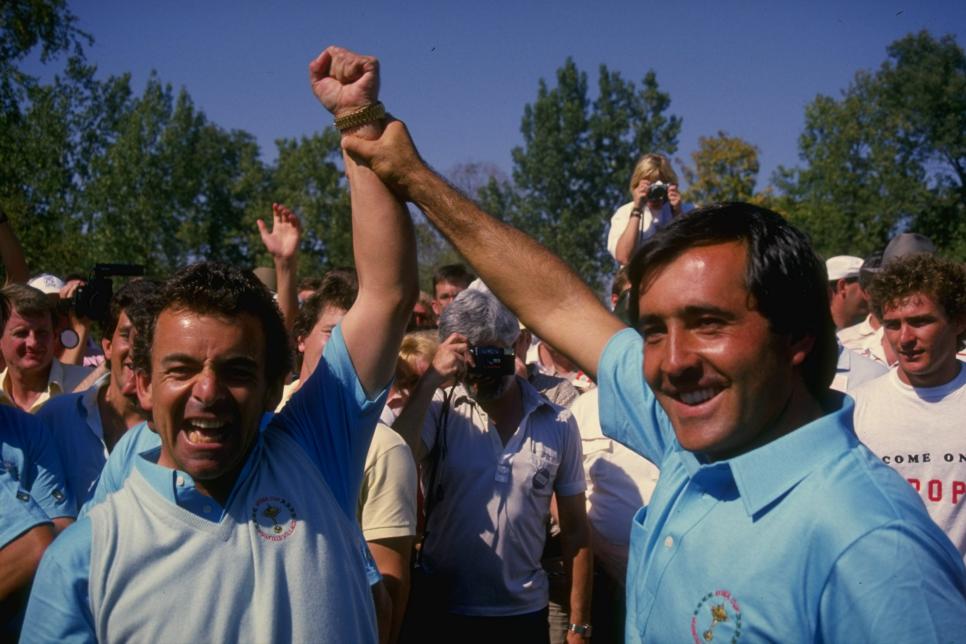voices
Ryder Cup 2023: 50 years of memories evoke images both dear and disheartening

The 1973 U.S. team poses with the Ryder Cup at Muirfield.
Getty Images
ROME — Exactly half a century of watching Ryder Cups live and from a distance has provoked a range of emotions.
Initially, there was the delight 13-year-old me felt as I took in the 1973 version at Muirfield. For someone that age to see the likes of Jack Nicklaus, Lee Trevino, Arnold Palmer, Billy Casper and Tom Weiskopf up close was an unforgettable thrill and education.
The memories linger still.
There was the sight of then-U.K. Prime Minister Ted Heath showing up for what I would only years later realize was nothing more than a tacky photo opportunity—the man barely knew what end of a club was which.
There was Chi Chi Rodriguez wearing what looked to me a ridiculous fur coat as he watched a session of play from which his captain, Jackie Burke, had decided he was excess to requirements. I can still see spectator Chi Chi dropping an apple core over the wall left of the ninth green. Big green one it had been before he started eating.
There was the same Rodriguez celebrating dramatically in the wake of his partner, Lou Graham, making a putt on the 18th green to halve their match with Tony Jacklin and Peter Oosterhuis. Time after time he bent over and punched the air.
Hang on. Did I mention there was another team in attendance, one representing Great Britain & Ireland? No Europeans back then.
So there was Peter Butler making the first-ever Ryder Cup hole-in-one. And Bernard Gallacher going down with food poisoning (we’ll leave that subject alone).

Lee Trevino at the 1973 Ryder Cup.
Don Morley
Ah, but then there was Trevino.
Not much more than a year earlier I’d watched Lee win the Open at Muirfield, a victory complete with everything designed to entrance a golf-mad kid’s eyes. He didn’t chip-in on every hole. It just seemed like it. Anyway, in September 1973, my dad and I were treated to an hour of Trevino on the range at Muirfield. It was an unforgettable education, one that lives with me still. The man was and is a ball-striking genius.
That Ryder Cup actually did resemble today’s version in that there were sizeable crowds to watch the action, something that wasn’t the case when the matches were played in the States. Even as late as 1983—when the world realized that the thing was actually competitive—hardly anyone was at PGA National in Florida to watch the U.S. win by a point.
Muirfield was packed though, to see the Americans ease to a comfortable but not overwhelming victory. As a measure of how things have changed, at precisely the same time Welshman Brian Huggett was on the course alongside his fourball partner, Maurice Bembridge (beating Nicklaus and Palmer), his wife was in the hospital giving birth to their daughter.
Different times indeed.
Inevitably, since those far-off days, the Ryder Cup has evolved in more ways than we can count. Much of it might even be labeled “advancement.” On the course the biennial contest between the best golfers on either side of the Atlantic has grown exponentially. From not much more than an informal garden party, where the result was both unimportant and preordained, such was the gulf in class between the sides, it is now golf’s most high-profile event outside of the four major championships. And maybe even higher than that. For those with no active interest in the game, the Ryder Cup surely provokes more of a reaction than, say, the PGA Championship.
With increased attention, of course, has come bigger crowds, more money and more pressure on the players. But it works both ways. Especially on the European side, otherwise relatively uneventful careers can be defined and enhanced by outstanding performances in the Ryder Cup. While Lanny Wadkins is possibly the last American star whose name provokes an instant “Ryder Cup” reaction, I give you Paul McGinley, Eamonn Darcy, Christy O’Connor Jr. and Philip Walton, all of whom distinguished themselves in moments of high stress. The matches have always loved the Irish, for some mysterious reason.
The 1980s were actually a grand time for the Ryder Cup. Both teams won the trophy and the thing started to creep into the wider public consciousness. The matches looked like fun. Which they always are in one respect, if only because match play is the most fascinating form of competition. Stroke play, it should be noted, only becomes truly interesting when it morphs into match play near the end of the weekly 72-hole marathon.

Europe's Colin Montgomerie and Paul Lawrie were all smiles early in the week of the 1999 Ryder Cup, when Europe took a 6-2 lead after Day 1.
JOHN MOTTERN
Still, for every upside there tends to be an equivalent down. Those larger galleries I mentioned have too often introduced a distasteful element of partisanship into the proceedings. The first hint of this came at Kiawah Island in 1991, the so-called “War on the Shore.” Quite apart from the fact that invoking mortal combat in a sporting arena is clearly inappropriate, the behavior of too many spectators reached a new low—at the time—in South Carolina.
And let’s not delve too deeply into just how Hale Irwin’s wildly inaccurate drive off the 18th tee in his match-deciding game with Bernhard Langer somehow made its way back to the fairway.
The nadir, however, came at The Country Club in 1999. There, the European players—in particular the Old World’s best, Colin Montgomerie—were subjected to a level of spectator abuse that can only be described as vile. I walked with Monty’s singles match against Payne Stewart. Never seen or heard anything like it before or since. Some of the language emanating from the boozed-up gallery cannot be repeated here, fit as it was for only an X-rated movie. The day, however, was rescued by the behavior of Stewart—who tragically would die only a month or so later. He had the good grace to have a number of the most egregiously obnoxious spectators removed from the premises. That day, Stewart was a proper golfer behaving like a proper golfer.

David Cannon
Sadly, since that day, the Ryder Cup has never again been what it used to be, a match between countries who had—apart from that unfortunate American independence thing—always fought on the same side in real Wars. It’s pathetic really. In the wake of the 2012 Ryder Cup at Medinah, one of the visiting European players told me that he had been heckled on every full shot he hit over the three days. Over a game of golf between friends. Really?
It is my belief that no true golfer would ever do such a thing, but today a nastiness that has never had any place in golf is part of the Ryder Cup equation. All of which is a far cry from 1973. Back then, it would have been unthinkable for any leading U.S player to be heckled or booed. Quite the opposite, actually. Starting with Bobby Jones, the best Americans have forever been hailed as near-immortals in my homeland of Scotland. I miss that aspect of the Ryder Cup.
Indeed, over the course of the last half-century, perhaps no one has done more to raise the profile of the Ryder Cup than Seve Ballesteros. But even his influence hasn’t always been a force for good. While the introduction of a more competitive atmosphere was surely a good thing, the great Spaniard was prone to taking things a little too far on multiple occasions, such was his desire to win. Victory is important, but not so important that players cannot walk away friends.
The news isn’t all bad though. As is well-documented, the income the DP World Tour derives from a home Ryder Cup like the one we will see this week at the Marco Simone Country Club near Rome is large enough to fund the circuit’s activities for the next four years. It is the ultimate cash cow, one that is unlikely to stop growing as we lurch ever further into the 21st century.
This is a subject that provokes mixed feelings. While it is impossible to deny the significance of the financial aspect of the Ryder Cup, it has grown to be something that is, in some ways, almost grotesque. For one thing, the lengthy build-up has reached nonsensical proportions. There really isn’t that much of interest to say about a match involving only 24 players. But the level of scrutiny continues to grow to a point where it has all become a bit silly. It is easy to think the event is just too big, or at least bigger than it should be.
Winning is another thing that has become too important, to a point where, if the organizers on both sides of the pond continue on their current paths, the matches will be damaged. If, as has been the case sine 2012, the home team routinely wins comfortably on a course set up to highlight the strengths of the home players and the weaknesses of the opposition, then interest will inevitably wane. The Ryder Cup will slide into being the mediocre and predictable spectacle that is the Presidents Cup.
This week we will be treated to a seemingly endless parade of trivialities, somehow treated as significant. This morning I received an e-mail telling me the pairings for each team’s practice rounds. Practice rounds! Then there were the team photographs, sessions we were told contained “unique banter,” a claim I seriously doubt. There will be much talk, too, of wives and girlfriends and what they will be wearing at the ostentatiously expensive gala dinner.
Give me strength.
It’s all about money, of course, the golf a secondary factor until the first ball is struck in what used to be sportsmanship but is now 100 percent about winning and losing. There is but one saving grace. As it always does, the game will take over and win the three days of the matches, no matter the final score. So, roll on Friday. And, while we’re about it, yearn for the ethos of 1973 and Trevino on the range.

